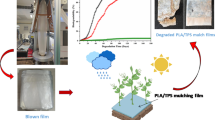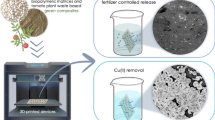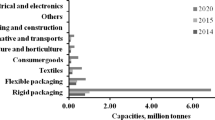Abstract
Poly(lactic acid) (PLA) is a sustainable, biodegradable polymer with high brittleness, elastic modulus, poor ductility, and low tensile strain that might restrict the packaging applications. The properties of PLA can be modified by addition of various materials. This study intended to reveal the effect of PLA with various concentrations of tomato peel extract (TPE) on the morphological, structural, thermal, and mechanical properties of PLA/TPE biocomposites. TPE was incorporated into the PLA matrix at 2, 4, and 6% w/w. The morphological analysis showed that films were successfully prepared by a combination of solvent-casting and compression-molding. TPE was well dispersed at low concentrations, though at higher concentrations above 2% w/w, an agglomeration of the TPE was observed. Thermal analysis revealed that the glass transition temperature of the biocomposites decreased with increasing content of TPE. FTIR spectra of the biocomposites showed that several components of TPE, such as phenolic compounds and fatty acid esters, could be incorporated into the matrix. Better mechanical performance was obtained for 2 and 4% w/w of TPE content in terms of tensile strain (between 2.4 and 38% higher compared to neat PLA) that was an indication of higher mechanical flexibility. These results showed the application performance of TPE in packaging materials.
Graphical abstract








Similar content being viewed by others
Data availability
The data supporting the findings of this study are available within the manuscript.
References
Xiao H, Yang L, Ren X, Jiang T, Yeh JT (2010) Kinetics and crystal structure of poly(lactic acid) crystallized nonisothermally: effect of plasticizer and nucleating agent. Polym Compos 31:2057–2068
Rasal RM, Janorkar AV, Hirt DE (2010) Poly(lactic acid) modifications. Prog Polym Sci 35:338–356
Gan I, Chow WS (2018) Antimicrobial poly(lactic acid)/cellulose bionanocomposite for food packaging application: a review. Food Packag Shelf Life 17:150–161
Edward MSG, Louis ACF, Srinivasan H, Venkatachalam S (2022) A mechanochemical approach for synthesizing almond shell nanoparticles and their potential application on the enhancement of polylactic acid film properties. Iran Polym J 31:1523–1535
Jamshidian M, Tehrany EA, Imran M, Jacquot M, Desobry S (2010) Poly-lactic acid: production, applications, nanocomposites, and release studies. Compr Rev Food Sci Food Saf 9:552–571
Muller J, González-Martínez C, Chiralt A (2017) Combination of poly(lactic) acid and starch for biodegradable food packaging. Materials 10:952
Sangeetha VH, Deka H, Varghese TO, Nayak SK (2018) State of the art and future prospectives of poly(lactic acid) based blends and composites. Polym Compos 39:81–101
Darie-Niţə RN, Vasile C, Irimia A, Lipşa R, Râpə M (2016) Evaluation of some eco-friendly plasticizers for PLA films processing. J Appl Polym Sci 133:43223
Ordoñez R, Atarés L, Chiralt A (2022) Properties of PLA films with cinnamic acid: effect of the processing method. Food Bioprod Proc 133:25–33
Barczewski M, Mysiukiewicz O, Szulc J, Kloziński A (2019) Poly(lactic acid) green composites filled with linseed cake as an agricultural waste filler. Influence of oil content within the filler on the rheological behavior. J Appl Polym Sci 136:47651
Dorgan JR, Lehermeier H, Mang M (2000) Thermal and rheological properties of commercial grade poly(lactic acids)s. J Polym Environ 8:1–9
Nofar M, Maani A, Sojoudi H, Heuzey MC, Carreau PJ (2015) Interfacial and rheological properties of PLA/PBAT and PLA/PBSA blends and their morphological stability under shear flow. J Rheol 59:317–333
Hemmati F, Farizeh T, Mohammadi-Roshandeh J (2021) Lignocellulosic fiber-reinforced PLA green composites: effects of chemical fiber treatment. In: Hameed Sultan MT, Majid MSA, Jamir MRM, Azmi AI, Saba N (eds) Biocomposite Materials. Composites Science and Technology. Springer, pp 97–204
Siakeng R, Jawaid M, Ariffin H, Sapuan SM (2019) Mechanical, dynamic, and thermomechanical properties of coir/pineapple leaf fiber reinforced polylactic acid hybrid biocomposites. Polym Compos 40:200–2011
Nofar M, Sacligil D, Carreau PJ, Kamal MR, Heuzey MC (2019) Poly(lactic acid) blends: processing, properties and applications. Int J Biolog Macromol 125:307–360
Van De Velde K, Kiekens P (2002) Biopolymers: overview of several properties and consequences on their applications. Polym Test 21:433–442
Pasha HY, Mohtasebi SS, Taherimehr M, Tabatabaeekoloor R, Firouz MS, Javadi A (2023) New poly(lactic acid)-based nanocomposite films for food packaging applications. Iran Polym J, In press
Biswas A, Cheng HN, Kuzniar G, He Z, Kim S, Furtado RF, Alves CR, Sharma BK (2023) Bilayer films of poly(lactic acid) and cottonseed protein for packaging applications. Polymers (Basel) 15:6
Martins C, Vilarinho F, Sanches Silva A, Andrade M, Machado AV, Castilho MC, Sá A, Cunha A, Vaz MF, Ramos F (2018) Active polylactic acid film incorporated with green tea extract: development, characterization and effectiveness. Ind Crops Prod 123:100–110
Safaei M, Roosta Azad R (2020) Preparation and characterization of poly-lactic acid based films containing propolis ethanolic extract to be used in dry meat sausage packaging. J Food Sci Technol 57:1242–1250
Llana-Ruiz-Cabello M, Pichardo S, Bermúdez JM, Baños A, Núñez C, Guillamón E, Aucejo S, Cameán AM (2016) Development of PLA films containing oregano essential oil (Origanum vulgare L. virens) intended for use in food packaging. Food Addit Contam Part A Chem Anal Control Expo Risk Assess 33:1374–1386
Noori N, Khanjari A, Rezaeigolestani M, Karabagias IK, Mokhtari S (2021) Development of antibacterial biocomposites based on poly(lactic acid) with spice essential oil (pimpinellaanisum) for food applications. Polymers (Basel) 13:3791
Khodayari M, Basti AA, Khanjari A, Misaghi A, Kamkar A, Shotorbani PM, Hamedi H (2019) Effect of poly(lactic acid) films incorporated with different concentrations of Tanacetum balsamita essential oil, propolis ethanolic extract and cellulose nanocrystals on shelf life extension of vacuum-packed cooked sausages. Food Packag Shelf Life 19:200–209
Ardjoum N, Chibani N, Shankar S, Ben FY, Djidjelli H, Lacroix M (2021) Development of antimicrobial films based on poly(lactic acid) incorporated with Thymus vulgaris essential oil and ethanolic extract of Mediterranean propolis. Int J Biol Macromol 185:535–542
Stoll L, Rech R, Flôres SH, Nachtigall SMB, de Oliveira RA (2019) Poly(acid lactic) films with carotenoids extracts: release study and effect on sunflower oil preservation. Food Chem 281:213–221
Zeid A, Karabagias IK, Nassif M, Kontominas MG (2019) Preparation and evaluation of antioxidant packaging films made of polylactic acid containing thyme, rosemary, and oregano essential oils. J Food Process Preserv 43:e14102
Szabo K, Cătoi AF, Vodnar DC (2018) Bioactive compounds extracted from tomato processing by-products as a source of valuable nutrients. Plant Food Human Nutr 73:268–277
Saini RK, Moon SH, Keum YS (2018) An updated review on use of tomato pomace and crustacean processing waste to recover commercially vital carotenoids. Food Res Int 108:516–529
Benítez JJ, Castillo PM, del Río JC, León-Camacho M, Domínguez E, Heredia A, Guzmán-Puyol S, Athanassiou A, Heredia-Guerrero JA (2018) Valorization of tomato processing by-products: fatty acid extraction and production of bio-based materials. Materials 11:2211
Ibrahim S, Riahi O, Said SM, Sabri MFM, Rozali S (2019) Biopolymers from crop plants. In: Reference module in materials science and Materials Engineering, Elsevier pp 1–10
Graça J (2015) Suberin: the biopolyester at the frontier of plants. Front Chem 3:62
López-Casado G, Matas AJ, Domínguez E, Cuartero J, Heredia A (2007) Biomechanics of isolated tomato (Solanum lycopersicum L.) fruit cuticles: the role of the cutin matrix and polysaccharides. J Exp Bot 58:3875–3883
Philippe G, Gaillard C, Petit J, Geneix N, Dalgalarrondo M, Bres C, Mauxion JP, Franke R, Rothan C, Schreiber L, Marion D, Bakan B (2016) Ester cross-link profiling of the cutin polymer of wild-type and cutin synthase tomato mutants highlights different mechanisms of polymerization. Plant Physiol 170:807–820
Parsons EP, Popopvsky S, Lohrey GT, Alkalai-Tuvia S, Perzelan Y, Bosland P, Bebeli PJ, ParanI FE, Jenks MA (2013) Fruit cuticle lipid composition and water loss in a diverse collection of pepper (Capsicum). Physiol Plant 149:160–174
Dominguez E, Heredia-Guerrero JA, Heredia A (2011) The biophysical design of plant cuticles: an overview. New Phytolog 189:938–949
Takahashi Y, Tsubaki S, Sakamoto M, Watanabe S, Azuma JI (2012) Growth-dependent chemical and mechanical properties of cuticular membranes from leaves of Sonneratia alba. Plant Cell Environ 35:1201–1210
Dominguez E, Espaa L, Lpez-Casado G, Cuartero J, Heredia A (2009) Biomechanics of isolated tomato (Solanum lycopersicum) fruit cuticles during ripening: the role of flavonoids. Funct Plant Biolog 36:613–620
Marc M, Risani R, Desnoes E, Falourd X, Pontoire B, Rodrigues R, Escórcio R, Batista AP, Valentin R, Gontard N, Pereira CS, Lopez C, Leroy E, Lourdin D, Marion D, Bakan B (2021) Bioinspired co-polyesters of hydroxy-fatty acids extracted from tomato peel agro-wastes and glycerol with tunable mechanical, thermal and barrier properties. Ind Crops Prod 170:113718
Manrich A, Moreira FKV, Otoni CG, Lorevice MV, Martins MA, Mattoso LHC (2017) Hydrophobic edible films made up of tomato cutin and pectin. Carbohydr Polym 164:83–91
Cifarelli A, Cigognini I, Bolzoni L, Montanari A (2016) Cutin isolated from tomato processing byproducts: extraction methods and characterization. In: 4th Int Conf Sustain 581 Solid Waste Manag 1–20
Szymanska-Chargot M, Chylinska M, Gdula K, Koziol A, Zdunek A (2017) Isolation and characterization of cellulose from different fruit and vegetable pomaces. Polymers (Basel) 9:495
Ferri JM, Garcia-Garcia D, Montanes N, Fenollar O, Balart R (2017) The effect of maleinized linseed oil as biobased plasticizer in poly(lactic acid)-based formulations. Polym Int 66:882–891
Schild G, Sixta H, Testova L (2010) Multifunctional alkaline pulping, delignification and hemicellulose extraction. Cell Chem Technol 44:35–45
Mussatto SI, Fernandes M, Roberto IC (2007) Lignin recovery from brewer’s spent grain black liquor. Carbohydr Polym 70:218–223
Graça J, Lamosa P (2010) Linear and branched poly(ω-hydroxyacid) esters in plant cutins. J Agric Food Chem 58:9666–9674
Heredia-Guerrero JA, Benítez JJ, Domínguez E, Bayer IS, Cingolani R, Athanassiou A, Heredia A (2014) Infrared and raman spectroscopic features of plant cuticles: a review. Front Plant Sci 5:305
Scavée GML (2018) Synthesis and investigation of the bio-polymerization of cutin monomers and derivatives. PhD Thesis, Technical University of Denmark
Martin LBB, Rose JKC (2014) There’s more than one way to skin a fruit: formation and functions of fruit cuticles. J Exp Bot 65:4639–4651
Bonilla J, Fortunati E, Vargas M, Chiralt A, Kenny JM (2013) Effects of chitosan on the physicochemical and antimicrobial properties of PLA films. J Food Eng 119:236–243
Tedeschi G, Benitez JJ, Ceseracciu L, Dastmalchi K, Itin B, Stark RE, Heredia A, Athanassiou A, Heredia-Guerrero JA (2018) Sustainable fabrication of plant cuticle-like packaging films from tomato pomace agro-waste, beeswax, and alginate. ACS Sustain Chem Eng 6:14955–14966
Chen K, Liao C, Li P, Li X, Li X, Zuo Y (2022) A compatible interface of wheat straw/polylactic acid composites collaborative constructed using KH570–nano TiO2. J Polym Environ 30:2209–2221
Szymańska-Chargot M, Chylińska M, Pieczywek PM, Walkiewicz A, Pertile G, Frąc M, Cieślak KJ, Zdunek A (2020) Evaluation of nanocomposite made of polylactic acid and nanocellulose from carrot pomace modified with silver nanoparticles. Polymers (Basel) 12:812
Dai L, Li R, Liang Y, Liu Y, Zhang W, Shi S (2022) Development of pomegranate peel extract and nano ZnO co-reinforced polylactic acid film for active food packaging. Membranes (Basel) 12:1108
Cacciotti I, Mori S, Cherubini V, Nanni F (2018) Eco-sustainable systems based on poly(lactic acid), diatomite and coffee grounds extract for food packaging. Int J Biol Macromol 112:567–575
Brito GF, Agrawal P, Mélo TJA (2016) Mechanical and morphological properties of PLA/bioPE blend compatibilized with E-GMA and EMA-GMA copolymers. Macromol Symp 367:176–182
Wang Q, Hu Y, Zhu J, Liu Y, Yang X, Bian J (2012) Convenient synthetic method of starch/lactic acid graft copolymer catalyzed with sodium hydroxide. Bull Mater Sci 35:415–418
Jordá-Vilaplana A, Fombuena V, García-García D, Samper MD, Sánchez-Nácher L (2014) Surface modification of polylactic acid (PLA) by air atmospheric plasma treatment. Eur Polym J 58:22–33
Rocca-Smith JR, Karbowiak T, Marcuzzo E, Sensidoni A, Piasente F, Champion D, Heinz O, Vitry P, Bourillot E, Lesniewska E, Debeaufort F (2016) Impact of corona treatment on PLA film properties. Polym Degrad Stab 132:109–116
Zou H, Yi C, Wang L, Liu H, Xu W (2009) Thermal degradation of poly(lactic acid) measured by thermogravimetry coupled to Fourier transform infrared spectroscopy. J Therm Anal Calorim 97:929–935
Torres-Huerta AM, Del Angel-López D, Domínguez-Crespo MA, Palma-Ramírez D, Perales Castro ME, Flores-Vela A (2016) Morphological and mechanical properties dependence of PLA amount in PET matrix processed by single-screw extrusion. Polym Plast Technol Eng 55:672–683
Szymanska-Chargot M, Zdunek A (2013) Use of FT-IR spectra and PCA to the bulk characterization of cell wall residues of fruits and vegetables along a fraction process. Food Biophys 8:29–42
Toscano G, Pizzi A, Foppa Pedretti E, Rossini G, Ciceri G, Martignon G, Duca D (2015) Torrefaction of tomato industry residues. Fuel 143:89–97
Mallampati R, Valiyaveettil S (2012) Application of tomato peel as an efficient adsorbent for water purification—alternative biotechnology? RSC Adv 2:9914–9920
Midhun Prasad K, Murugavelh S (2020) Experimental investigation and kinetics of tomato peel pyrolysis: performance, combustion and emission characteristics of bio-oil blends in diesel engine. J Clean Prod 254:120115
Kızılırmak Esmer Ö, Koçak E, Cevrem AE, Kıcıkoğlu O (2022) Alkali extraction of phenolic compounds from tomato peel: optimization of extraction conditions and investigation of phenolic profile by LC-MS/MS. Turk J Agric Food Sci Technol 10:2966–2976
Benítez JJ, Heredia-Guerrero JA, Guzmán-Puyol S, Barthel MJ, Domínguez E, Heredia A (2015) Polyhydroxy ester films obtained by non-catalyzed melt-polycondensation of natural occurring fatty polyhydroxyacids. Front Mater 2:1–10
Mandal DK, Bhunia H, Bajpai PK (2019) Thermal degradation kinetics of PP/PLA nanocomposite blends. J Thermoplast Compos Mater 32:1714–1730
Hassouna F, Raquez JM, Addiego F, Dubois P, Toniazzo V, Ruch D (2011) New approach on the development of plasticized polylactide (PLA): grafting of poly(ethylene glycol) (PEG) via reactive extrusion. Eur Polym J 47:2134–2144
Rapa M, Nita RND, Vasile C (2017) Influence of plasticizers over some physico-chemical properties of PLA. Mater Plast 54:73–78
Cao X, Mohamed A, Gordon SH, Willett JL, Sessa DJ (2003) DSC study of biodegradable poly(lactic acid) and poly(hydroxy ester ether) blends. Thermochim Acta 406:115–127
Heredia-Guerrero JA, Goldoni L, Benítez JJ, Davis A, Ceseracciu L, Cingolani R, Bayer IS Heinze T, Koschella A, Heredia A, Athanassiou A (2017) Cellulose-polyhydroxylated fatty acid ester-based bioplastics with tuning properties: acylation via a mixed anhydride system. Carbohydr Polym 173:312–320
Acknowledgements
The present study was supported by the Ege University Scientific Research Projects Coordination with the Project ID: FGA-2022-23383.
Author information
Authors and Affiliations
Corresponding author
Rights and permissions
Springer Nature or its licensor (e.g. a society or other partner) holds exclusive rights to this article under a publishing agreement with the author(s) or other rightsholder(s); author self-archiving of the accepted manuscript version of this article is solely governed by the terms of such publishing agreement and applicable law.
About this article
Cite this article
Kocak, E., Cetin, M.S., Kizilirmak Esmer, O. et al. Effects of tomato peel extract on morphological, chemical, thermal, and mechanical properties of poly(lactic acid). Iran Polym J 32, 1135–1148 (2023). https://doi.org/10.1007/s13726-023-01187-4
Received:
Accepted:
Published:
Issue Date:
DOI: https://doi.org/10.1007/s13726-023-01187-4




